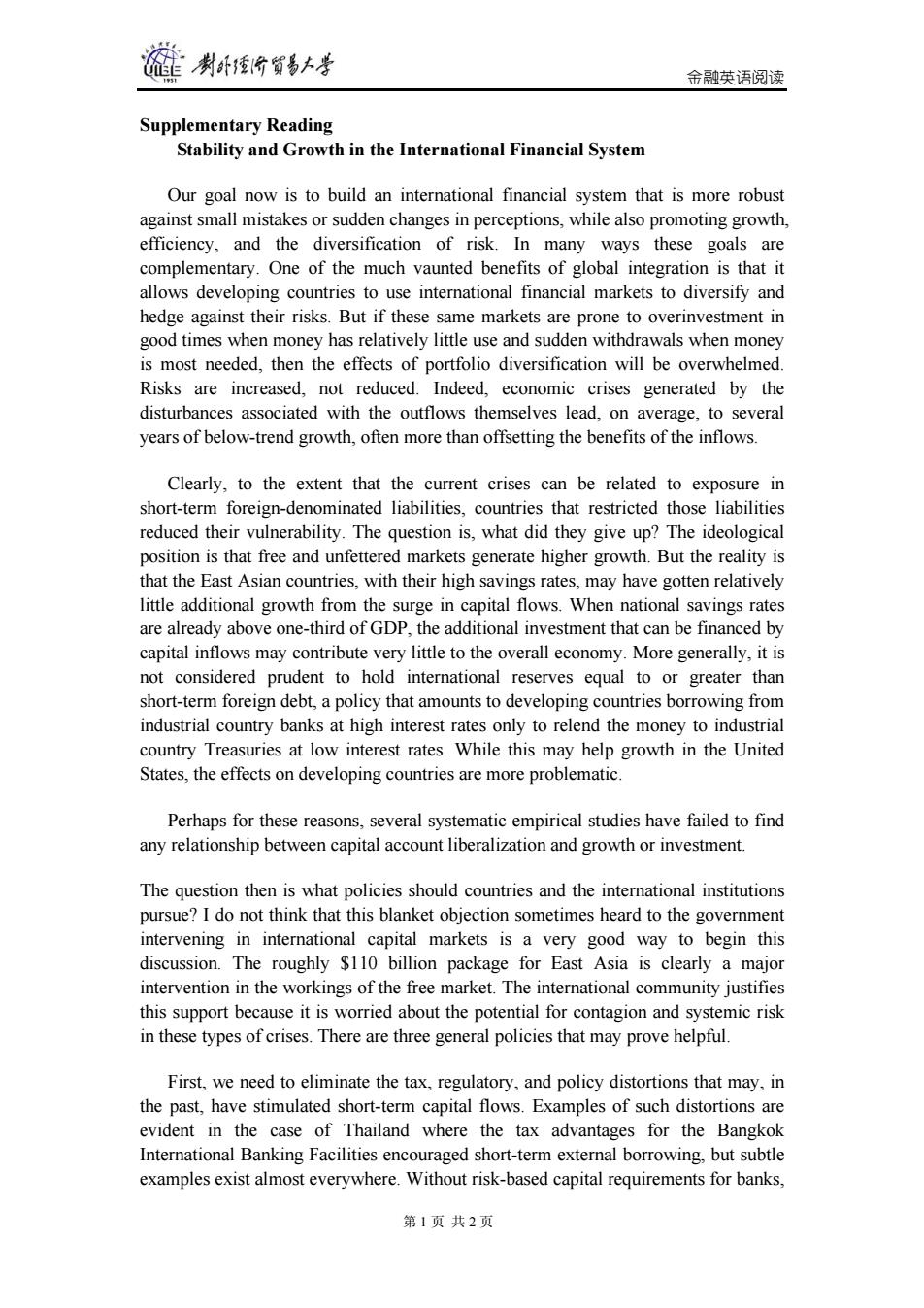正在加载图片...

制卧爱分贸易+学 金融英语阅读 Supplementary Reading Stability and Growth in the International Financial System Our goal now is to build an international financial system that is more robust against small mistakes or sudden changes in perceptions,while also promoting growth, efficiency,and the diversification of risk.In many ways these goals are complementary.One of the much vaunted benefits of global integration is that it allows developing countries to use international financial markets to diversify and hedge against their risks.But if these same markets are prone to overinvestment in good times when money has relatively little use and sudden withdrawals when money is most needed,then the effects of portfolio diversification will be overwhelmed. Risks are increased,not reduced.Indeed,economic crises generated by the disturbances associated with the outflows themselves lead,on average,to several years of below-trend growth,often more than offsetting the benefits of the inflows. Clearly,to the extent that the current crises can be related to exposure in short-term foreign-denominated liabilities,countries that restricted those liabilities reduced their vulnerability.The question is,what did they give up?The ideological position is that free and unfettered markets generate higher growth.But the reality is that the East Asian countries,with their high savings rates,may have gotten relatively little additional growth from the surge in capital flows.When national savings rates are already above one-third of GDP,the additional investment that can be financed by capital inflows may contribute very little to the overall economy.More generally,it is not considered prudent to hold international reserves equal to or greater than short-term foreign debt,a policy that amounts to developing countries borrowing from industrial country banks at high interest rates only to relend the money to industrial country Treasuries at low interest rates.While this may help growth in the United States,the effects on developing countries are more problematic. Perhaps for these reasons,several systematic empirical studies have failed to find any relationship between capital account liberalization and growth or investment. The question then is what policies should countries and the international institutions pursue?I do not think that this blanket objection sometimes heard to the government intervening in international capital markets is a very good way to begin this discussion.The roughly $110 billion package for East Asia is clearly a major intervention in the workings of the free market.The international community justifies this support because it is worried about the potential for contagion and systemic risk in these types of crises.There are three general policies that may prove helpful First,we need to eliminate the tax,regulatory,and policy distortions that may,in the past,have stimulated short-term capital flows.Examples of such distortions are evident in the case of Thailand where the tax advantages for the Bangkok International Banking Facilities encouraged short-term external borrowing,but subtle examples exist almost everywhere.Without risk-based capital requirements for banks, 第1页共2页金融英语阅读 Supplementary Reading Stability and Growth in the International Financial System Our goal now is to build an international financial system that is more robust against small mistakes or sudden changes in perceptions, while also promoting growth, efficiency, and the diversification of risk. In many ways these goals are complementary. One of the much vaunted benefits of global integration is that it allows developing countries to use international financial markets to diversify and hedge against their risks. But if these same markets are prone to overinvestment in good times when money has relatively little use and sudden withdrawals when money is most needed, then the effects of portfolio diversification will be overwhelmed. Risks are increased, not reduced. Indeed, economic crises generated by the disturbances associated with the outflows themselves lead, on average, to several years of below-trend growth, often more than offsetting the benefits of the inflows. Clearly, to the extent that the current crises can be related to exposure in short-term foreign-denominated liabilities, countries that restricted those liabilities reduced their vulnerability. The question is, what did they give up? The ideological position is that free and unfettered markets generate higher growth. But the reality is that the East Asian countries, with their high savings rates, may have gotten relatively little additional growth from the surge in capital flows. When national savings rates are already above one-third of GDP, the additional investment that can be financed by capital inflows may contribute very little to the overall economy. More generally, it is not considered prudent to hold international reserves equal to or greater than short-term foreign debt, a policy that amounts to developing countries borrowing from industrial country banks at high interest rates only to relend the money to industrial country Treasuries at low interest rates. While this may help growth in the United States, the effects on developing countries are more problematic. Perhaps for these reasons, several systematic empirical studies have failed to find any relationship between capital account liberalization and growth or investment. The question then is what policies should countries and the international institutions pursue? I do not think that this blanket objection sometimes heard to the government intervening in international capital markets is a very good way to begin this discussion. The roughly $110 billion package for East Asia is clearly a major intervention in the workings of the free market. The international community justifies this support because it is worried about the potential for contagion and systemic risk in these types of crises. There are three general policies that may prove helpful. First, we need to eliminate the tax, regulatory, and policy distortions that may, in the past, have stimulated short-term capital flows. Examples of such distortions are evident in the case of Thailand where the tax advantages for the Bangkok International Banking Facilities encouraged short-term external borrowing, but subtle examples exist almost everywhere. Without risk-based capital requirements for banks, 第 1 页 共 2 页